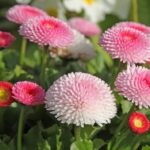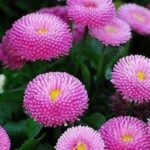Bellis, commonly known as English daisy or Bellis perennis, is a charming perennial that graces gardens with its dainty, daisy-like flowers. With their vibrant colors and low-growing habit, these plants are ideal for borders, containers, and even ground cover. Here’s a comprehensive guide on how to grow Bellis in your garden.
1. Understanding Bellis
Varieties:
- Bellis perennis: The most common variety, known for its white, pink, or red flowers with yellow centers.
- Bellis perennis ‘Pomponette’: A cultivated variety with larger, more double blooms.
- Bellis perennis ‘Habanera’: Features large, frilly flowers in vibrant colors.
Growth Habit:
- Bellis perennis is a low-growing perennial, reaching about 4-6 inches in height.
- The plants spread to form a dense mat, making them excellent for ground cover.
2. Choosing the Right Location
Sunlight:
- Bellis prefers full sun to partial shade. In hotter climates, some afternoon shade will prevent the flowers from wilting.
Soil:
- Well-drained soil is essential. Bellis thrives in rich, loamy soil with a neutral to slightly acidic pH (6.0 to 7.0).
- Amend heavy clay soils with compost or sand to improve drainage.
3. Planting Bellis
Starting from Seed:
- Bellis seeds can be sown directly in the garden in late spring or started indoors 6-8 weeks before the last frost.
- Sow seeds on the soil surface and lightly press them down. They require light to germinate, so do not cover them with soil.
- Keep the soil consistently moist until germination, which usually occurs in 14-21 days.
Transplanting:
- If starting indoors, transplant seedlings when they have at least two sets of true leaves and after the danger of frost has passed.
- Space plants about 6-12 inches apart to allow for adequate air circulation.
4. Caring for Bellis
Watering:
- Keep the soil evenly moist, especially during the growing season. Bellis prefers consistent moisture but does not tolerate waterlogged conditions.
Fertilizing:
- Feed with a balanced fertilizer once a month during the growing season to encourage healthy growth and abundant flowering.
Deadheading:
- Regularly remove spent flowers to encourage continuous blooming and prevent the plant from going to seed too quickly.
Mulching:
- Apply a thin layer of mulch around the plants to help retain soil moisture and suppress weeds.
5. Common Pests and Problems
Aphids:
- These small, sap-sucking insects can be controlled with insecticidal soap or by introducing beneficial insects like ladybugs.
Powdery Mildew:
- A common fungal issue, especially in humid conditions. Ensure good air circulation and avoid overhead watering to minimize the risk.
Slugs and Snails:
- These pests may be attracted to the moist conditions around Bellis. Use barriers, traps, or organic slug pellets to protect your plants.
6. Propagation and Maintenance
Division:
- Bellis can be divided every 2-3 years in the fall to maintain plant vigor and prevent overcrowding.
Self-Seeding:
- Bellis readily self-seeds, which can result in new plants popping up in unexpected places. If you want to control their spread, deadhead before seeds form.
7. Overwintering Bellis
- In colder climates, Bellis can survive mild winters with minimal protection. A light mulch or frost cloth may be used to protect the plants during harsh winter conditions.
8. Creative Uses for Bellis
- Ground Cover: Bellis is excellent for filling in bare spots in the garden.
- Borders and Edging: Their low-growing habit makes them perfect for borders or edging pathways.
- Containers: Bellis can be grown in pots or hanging baskets, bringing a splash of color to patios and balconies.
ds
perennis.
 careyfashion.com Carey Fashion
careyfashion.com Carey Fashion



















